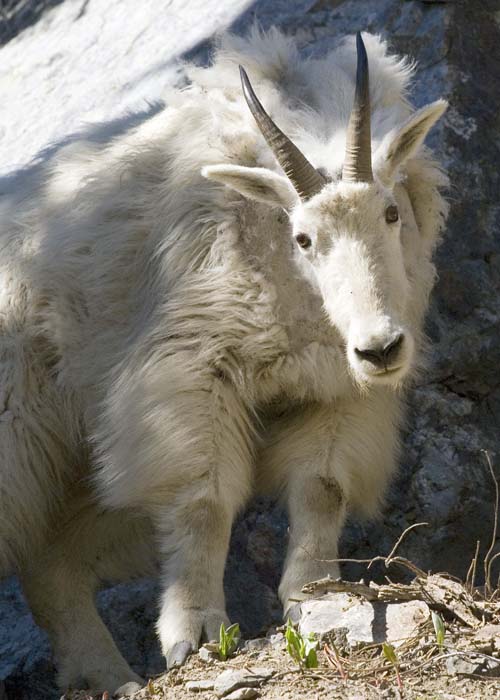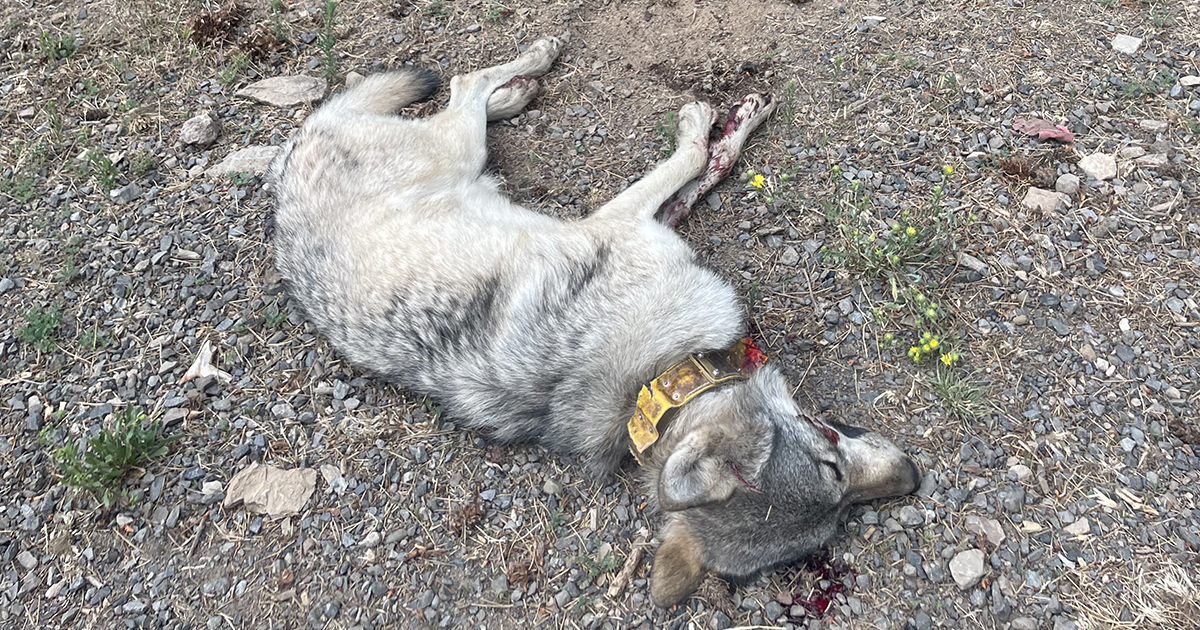Mountain goat hunter beats the odds. … and the weather
Published 9:00 am Saturday, March 16, 2024

- A mountain goat billy in the Elkhorn Mountains.
BAKER CITY — Chris Bocchi peered into the scope attached to the top of his rifle and prepared to complete a hunt that he had, in a sense, started almost three decades earlier.
Trending
Yet even with the weight of all those years, as Bocchi’s finger rested gently on the trigger he felt no great pressure.
He squeezed.
The 6.5 PCR bullet flew true for 375 yards.
Trending
The mature mountain goat billy slumped over.
Bocchi, 40, of Redmond, and his brother, Ryan, of Klamath Falls, started the steep hike down from the Elkhorn Crest National Recreation Trail about 15 miles west of Baker City.
Bocchi, who has been hunting since he was a pre-teen, was sure he could make the shot.
“I was very confident with my gun and my shooting,” he said.
But although he felt calm in those moments as the scope’s reticle centered on the goat’s shoulder, Bocchi said the hunt was not without stress.
Far from it.
He explains the source with one word that he all but spits out, his disdain still palpable five months later.
“Weather.”
Beating the odds
Bocchi first applied for a mountain goat hunting tag — a once-in-a-lifetime tag in Oregon — the first time he was eligible.
He was 12.
Many of his relatives put in for a tag every year too, more out of habit than anything.
“It’s a hunt you don’t ever plan on going on,” Bocchi said.
Based on the odds, it’s a bet that even the most naive gambler stepping into a Vegas casino would reconsider.
In 2023, Bocchi was one of 1,401 hunters who applied for one of the three tags during the Oct. 1-31 hunt in the Elkhorns.
But that year was different.
Or at least he hoped it was.
Bocchi doesn’t just wait to find out, come June, which of his applications was successful.
He also consults the seed number, which is randomly assigned to every application.
Based on the previous two years, Bocchi deduced that, based on the seed number for his 2023 goat tag application, he had a better-than-usual chance of drawing a tag.
No guarantees, to be sure.
Not with three tags and 1,401 applicants.
“But I knew I was on the scent,” Bocchi said.
Better than that.
He drew the tag.
Familiar ground
Bocchi didn’t need to do any research to prepare for his once-in-a-lifetime chance to bag an Oregon billy goat.
He was well-acquainted not only with the species, but also with the Elkhorns, where a significant portion of Oregon’s mountain goats roam.
(Only the Wallowas boast a larger population than the estimated 250 to 300 goats in the Elkhorns.)
Bocchi said his dad has hunted elk in the Elkhorns for decades.
He himself started hunting in the mountains when he was 12.
“I knew the Elkhorns very well,” he said. “When we were hunting elk we’d always see the goats.”
A couple years ago, Bocchi said he helped a friend from Redmond during her goat hunt in the Elkhorns.
But no matter his experience and familiarity, he was hardly content to just show up on Oct. 1 and see what happened.
“Pretty much every weekend last summer, and any days off I had, I spent scouting,” Bocchi said.
He works in Prineville, about 200 miles from Baker City. Many times after his work week ended he would drive straight to the Elkhorns.
Finding goats wasn’t the challenge, Bocchi said.
He knew that the largest share of the goat population in the Elkhorns lives in the southern half of the range, roughly between Marble Creek Pass and Cracker Saddle.
That’s the area where Bocchi focused during his scouting trips.
But though most people who hike the Elkhorn Crest Trail north from the pass, or visit the Twin Lakes basin, will see goats, and perhaps dozens, Bocchi said a hunter has a different perspective.
He was searching for a mature billy.
(Although hunters can legally kill any mountain goat, the Oregon Department of Fish and Wildlife prefers hunters target a mature billy. That’s one reason the agency requires goat hunters to attend an orientation class with an ODFW biologist before the season. Research during the 1960s, when goat hunting was allowed in the Wallowas, showed that when hunters killed older nannies, their loss seemed to have a disproportionate negative effect on goat herds.)
Because the difference between a young and a mature billy can amount to a couple inches of length on their distinctive black, dagger-like horns, extended examination through binoculars or a spotting scope is important, Bocchi said.
Weather builds the pressure
With September waning, Bocchi felt he was ready for the hunt.
The weather was not.
The morning of Sunday, Oct. 1, the first day of the season, dawned cold and wet.
The high temperature at the Baker City Airport — about 5,000 feet below the craggy peaks the goats prefer — was just 50 degrees.
Snow fell.
Even worse, fog clogged the Elkhorns.
“The weather was so bad,” Bocchi said. “You just couldn’t see.”
He had enlisted help from friends, from Grants Pass, Boise, Medford.
One brought horses to help haul the billy out of the mountains.
But the weather wrecked Bocchi’s finely honed strategy.
The friends all had to leave.
By the night of Wednesday, Oct. 4, his only companion in camp, near Deer Creek on the west side of the Elkhorns, was his brother, who had driven from Klamath Falls.
Bocchi had the whole month, but not really.
He had taken vacation for the first week, but thereafter he would only be able to hunt for maybe two or three days straight.
“The pressure started mounting,” he said. “That was the most stressful part of the whole hunt.”
But finally, on Thursday morning, Oct. 5, the clouds from the early autumn tempest had thinned. The air warmed (the high that day at the airport was 74).
The brothers drove to Marble Creek Pass and hiked north on the Elkhorn Crest Trail.
Bocchi glassed a few billies but none, he said, was a “shooter.”
The pair was preparing to head back to the pass when Ryan saw a lone billy not too far below.
“It looked different,” Bocchi said. “Better than what I’d been seeing.”
But he refused to rush.
He watched the billy for a while. He took a video and still photographs.
Taking advantage of the lofty spot and its strong cell signal, Bocchi even sent the views to a friend who’s also a taxidermist.
The friend’s impression was that the billy was a good one.
A “shooter,” in Bocchi’s term.
“He told me it was up to me,” Bocchi said.
He decided to take the shot.
Dream hunt ends without drama
For a hunt he had been thinking about, or at least aware of, for 28 years, the conclusion was anticlimactic.
Bocchi, who is used to stalking quarry that’s much more skittish, like bull elk, pointed out that goats, which are rarely hunted, are pretty placid.
The shot, from 375 yards, was relatively routine, he said.
Even the hike back to the ridge with the meat, head and hide wasn’t terribly taxing for the Elkhorns, a range that has no surfeit of easy ground.
“It was only 15 or 20 minutes,” Bocchi said.
He said his taxidermist friend scored the billy’s horns at 49 “and change.”
That would put it in the top 25 or so of goats taken in Oregon.
Bocchi plans to have a shoulder mount done.
And the rest of the hide will make a fine blanket.
“It’s so soft,” he said.
Mountain goats are the rarest big game animals that can be hunted in Oregon.
But though their population is modest — perhaps 1,000 to 1,200, although statistics are somewhat scarce — the animals aren’t at all elusive.
This is particularly so in the Elkhorn Mountains west of Baker City.
Because the goats are rarely hunted — the state sells just 21 tags annually, nine of those for three separate hunts in the Elkhorns — they lack the instinctive skittishness of deer, elk and most other wildlife.
Indeed, goats are quite inquisitive, although their affinity for people, biologists say, is not the fondness of a dog but results instead from the goats’ insatiable appetite for salt.
Which hikers and backpackers tend to supply copiously, through urine and the sweat that dampens hiking poles, fishing rods and other backcountry accouterments.
The locus of goats in the Elkhorns is the Twin Lakes basin.
After several hikers reported to the Oregon Department of Fish and Wildlife (ODFW) that they were worried by what they took for somewhat aggressive behavior by goats — although no one said they were attacked — ODFW tried to deflect the goats by setting out salt blocks away from popular campsites in the basin.
The state also placed signs at several spots around the Elkhorns to warn visitors that the goats, placid though they might seem, are wild animals that, with their powerful bodies and sharp horns, are quite capable of inflicting grievous injuries.
Justin Primus, assistant district wildlife biologist at ODFW’s Baker City office, said biologists there field an occasional complaint about the goats at Twin Lakes.
But those are rare, he said, maybe one or two every few years.
Unlike other big game animals, mountain goats, as befits their name, spend the entire year in the high country, rather than migrating to lower elevations as deer and elk tend to do.
Primus said the goats can survive the polar conditions in part because the combination of nearly incessant winds and steep terrain prevents snow from piling up in places. This allows the goats to dig through the scanty snow to find forage.
Because they spend most of their time on nearly vertical slopes, goats are well protected from most predators, Primus said.
Biologists have seen a few carcasses killed by cougars, he said.
There is no definitive evidence that mountain goats are native to Oregon.
ODFW started the herd in the Elkhorns by releasing 21 goats, trapped in Washington’s Olympic National Park and elsewhere, from 1983 through 1986.
The animals have thrived since.
The goats have proliferated to the point that, over the past 20 years or so, ODFW has trapped more than 150 goats near Goodrich Lake, in the Baker City watershed, and trucked them to other parts of Oregon and to other states.
Most of the goats were taken to the Wallowa Mountains. The Elkhorns have also served as the nursery for goat populations in the Strawberry Mountains south of Prairie City, the Mount Jefferson region in the central Cascades, and the Wenaha-Tucannon Wilderness in Union County.
— Jayson Jacoby
“I knew the Elkhorns very wel. When we were hunting elk we’d always see the goats.”
— Chris Bocchi









